|
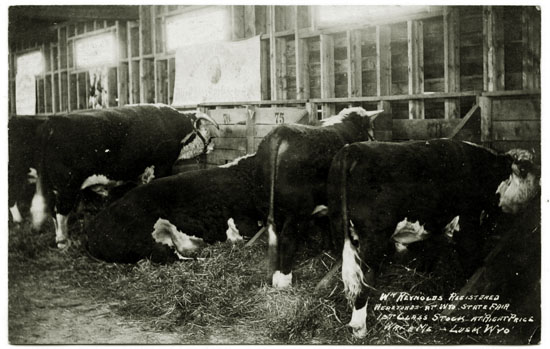
William M. Reynolds' herefords, undated.
Wm. M. Reynolds raised Herefords, Clydesdales, and Percherons near Lusk. He was a regular exhibitor at the
State Fair. The Herefords were registered. Others displayed prize animals. J. C. Shaw displayed
prize Chihuahua cattle as well as a sting of Belgian mares and stallions. gus Nylen won a prize for his
cavalry horse.
Although the rodeo continued, during 1914 through 1915, major emphasis at the State Fair were agricultural exhibits.
In 1914, Indians from Pine Ridge put in an appearance with James H. "Captain Jim" Cook. Cook with the
Indians captivated audiences. Cook had signed on with Ben Slaughter. After Little Big Horn had served as a guide on the Northern
Plains. He was the one who negotiated with Red Cloud to permit Professor Othniel Marsh to hunt bones on Indian Lands. See
Bone Wars. He served as a guide for Montegue Stevens in northern Wyoming and for
a time served as manager for the WS Ranch later made famous for having signed on Butch Cassidy and
other members of the Wild Bunch.
The major expansion of the Fair Grounds was the addition of "most comfortable rest room for ladies and children now equipped in the history of this town."
The expense of the rest room was borne by the Converse County Republican Committee." with entertainment consisted
to a great extent of vaudville type acts.
In 1915, fair constructed an addition to the Arts and Crafts Building, permitting additional space for agricultural exhibits. A brd show
was brought in. Origninally, Madame Marantette and her celebrated trained horses was booked.
Madame Marantette's act was cancelled and replaced by the Kimi-Wa Japanese troupe of balance artists and by Kent's trained seals.
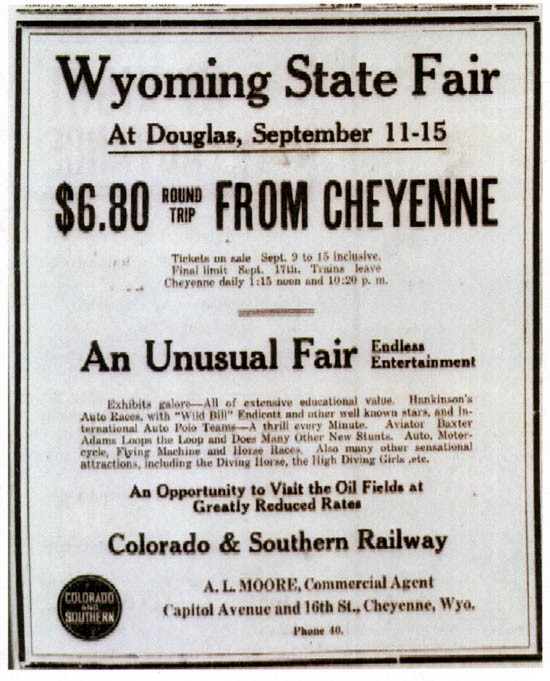
Advertisement 1916 Wyoming State Fair.
As seen by the advertisement, major amusements including aeroplanes, motorcyles races, automobile races were booked into
the 1916 fair. Other acts booked at the fair included "The Four
Roses," described as "aerobattle dancers:" a trio of gymnasts: a dog and pony show; Japanese
equillibrists; a grand opera quartette, and tumblers. The booking of special excursion trains was not
unusual. In 1917, Elks Lodge No. 660 in Cheyenne booked a special excursion train to the State Fair. The train
consisted of 3 pullman car and a chair car. The Elks brought their drum corps and d a calliope. The Elks promised to
"make a lot of noise," perhaps reminiscent of the old joke that there is both good news and
bad news relating to a calliope. The good news is that it can be heard a mile away. The bad news is that
it can be heard a mile away
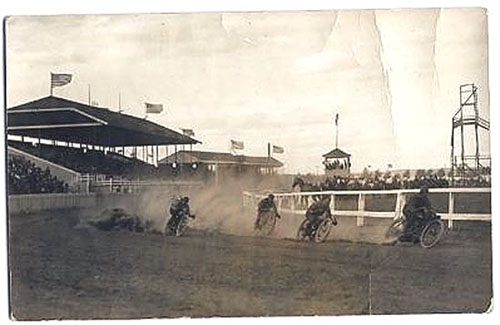
Motorcycle Race, Wyoming State Fair, approx. 1916.
The tall structure in the background is the ramp and platform for Doc Carver's Diving Horse act. See
next photo. Doc Carver's diving horse and "Lady in Red" appeared at the fair from 1916 to 1918.
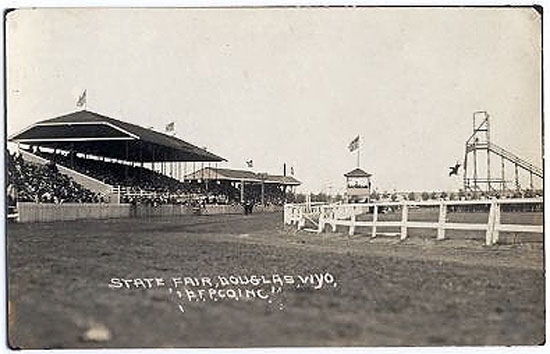
"Lady in Red" on Doc Carver's Diving Horse, Wyoming State Fair, 1916, photo by Ralph Doubleday.
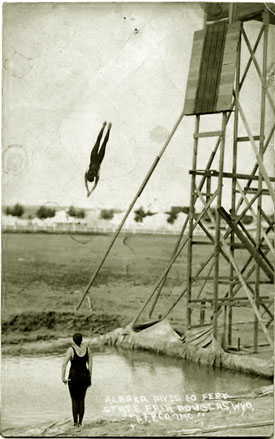 Doc Carver's diving girls, Wyoming State Fair.
Photo by Ralph Doubleday. Doc Carver's diving girls, Wyoming State Fair.
Photo by Ralph Doubleday.
William Frank "Doc" Carver (1840-1927), as a young man lived with the Sioux and Pawnee. In
1877, Carver went on tour giving exhibitions of shooting prowness. In 1883, Carver's reputation was assured
when he defeated Captain Adam Henry Bogardus, World Champion and United States Champion
trap shootist, in a series of 25 matches 19 times. Carver lost thrice and tied thrice.
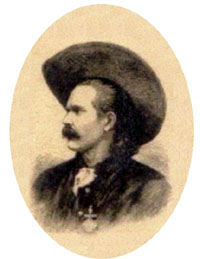 Doc Carver
Doc Carver
|
Doc Carver went on two European tours, performing before the Prince of
Wales (later Edward VII) and on his 1882 tour winning $80,000. From those winnings, in
1883, Carver invested $27,000 in a new Wild West show known as the "Rocky Mountain and
Prairie Exhibition" sponsored by Wm. F. Cody and Nate Salsbury. After one year,
Carver withdrew and Cody and Salsbury brought Captain Bogardus into the show, by then known as
"Buffalo Bill's Wild West." Captain Bogardus remained with the show for a year.
Allegedly, in the 1880's Carver was crossing a bridge which was partially collapsed. His horse dove into
the waters below, inspiring Carver to develope the diving horse act. Carver trained various
animals and went on tour. Included within the tour was his son, Al, who constructed the
ramp and tower. Others were brought into the show, including his future daughter-in-law, Sonora
Webster Carver who joined the show in 1924. The show became a permanent fixture at Atlantic City's Steel
Pier. There, his daughter and daughter-in-law continued the show following
Carver's death. Sonora Carver lost her eye sight when her horse "Red Lips" dove, off-balance, into the tank.
Blind, however, Sonora continued with the act. The act finally closed as a result of
pressure from amimal rights groups in the 1970's. Sonora Carver always, however, contended that
the horses were never forced to dive and, in fact, enjoyed the act. Sonora Carver died in
September 2003, age 99.
There was something going on all the time.
One of the more spectacular events of the 1916 and 1917 fairs was Baxter Adams (1885-1951) who performed loop the loops in his
aeroplane. In 1917, he raced his plane against an automobile circling the track. The Wyoming Tribune, September 13, 1917, described
the event:
Wild Bill Endicott and Baxter Adams furnished a few moments of excitedment when the two were pitted against
each other, the former driving his Sweeny Special and Baxter flying
over him around the half mile tract.
Following the exhibition Admas made his debut to the crowd as a trick aviator. He sent his
machine far over the heads of the spectators retuning in a hugh circle, doing as he did so the loop the loop, spiral dive and other fancy stunts which brought
hearty applause from the granstands. Several times he swooped down nearly touching the
ground when suddenly he sent his machine back again skyward and finally landing on the vacant lot adjoing the fair grounds.
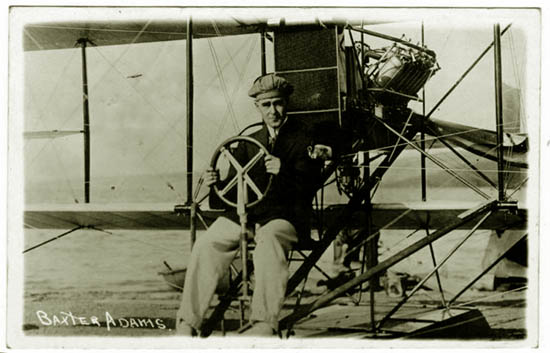
Baxter Adams, location unidentified, approx. 1916.
Rodeo, as it is today, was, however, the primary attaction. One of the contests was the "wild Horse Race."
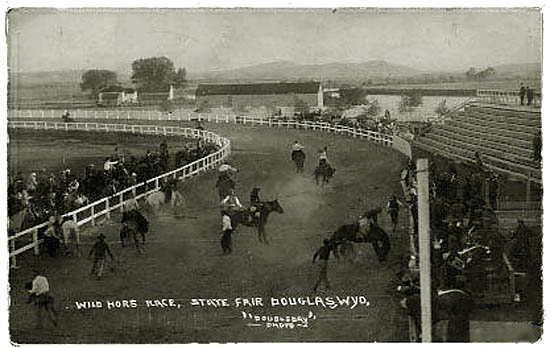
Wild Horse Race, Wyoming State Fair, 1916. Photo by Ralph Doubleday.
One of the participants in the Wild Horce Race was Richard Quay "Dick" Hornbuckle (1885-1951) of Ross, Wyoming.
In the bucking bronc contest he made a good account of himself. But in the Wild Horse Race he was badly hurt. He remained, however,
a noted all around rodeo cowboy, participating in both bulldogging and bronc contests.
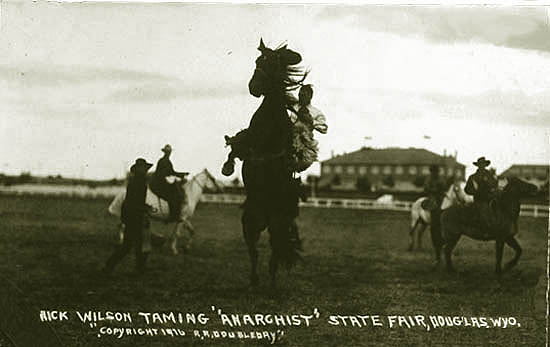
Rick Wilson on Anarchist , Wyoming State Fair, 1916. Photo by Ralph Doubleday.
Some horses were more famous than their riders. Such were horses such as Anarchist, Steamboat, Teddy Roosevelt, and
Midnight. Anarchist was a tough horse. The Wyoming Semi-Weekly Tribune noted three years earlier with regard to the
1913 Frontiers Day bucking contest:
Anarchist proved worthy of his name by kicking Maxie Johnson into insensibility, landing a left hook on the jaw of Si Smith, and milling
mightlilly under Wiliam Powell, who stuck like a burr.
But such injuries were regarded by the daily edition of the paper, August 23, as inconsequential:
Yesterday's program was marred by no serious accidents, despite sustained and strenuous actions.
Maxie Johnson, colored, was kicked in the side and stretched, stunned, with fractured ribs; Mrs. Hewlen Bowen was thrown in a relay race and rushed from
the track to an ambulance, but sustained no srious injury; Simon Smith was kicked in the
head and face, but merely temporarily disfigured; Trooper Smith was thrown in a Cossack race and sorely bruised; Kirt Acor was stunned when
bucked from an outlaw; Frank Stone suffered a similailarly ignomicious dissolution of his chances
of the championship, and a half-score of other contestants were trod upon, rolled upon, and walked upon by horses, but such
things are but indicdental to the Frontier type of celebration and demanded but momentary attention.
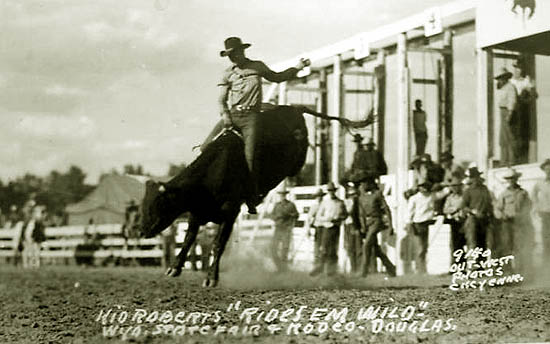
George "Kid" Roberts, Wyoming State Fair, approx. 1939. Photo by A. E. Gordon,
An important part of the Wyoming State Fair has always been the rodeo. Today, it is a Professional
Rodeo Cowboys Association sanctioned rodeo. While races such as rep races and roundup wagon races have disappeared from the
rodeo scene, other races have appeared. At the State Fair there is now conducted a "rubber ducky" race which
requires the participants to engage in a relay race in which one lap is done on horseback, the next rider does another lap
bare back, the third particpant on a four wheeler or similar conveyance and finally a fourth lap is done by one
particpant in a wheelbarrow pushed by another member of the team, all the while a rubber ducky is carried in the mouth of
a participant. Penalties are given for dropping the rubber ducky.
Music this page: "Arrival of the Elks March," arranged and sequenced by Horse Creek Cowboy for the
calliope.
Next Page, Doublas Continued.
|